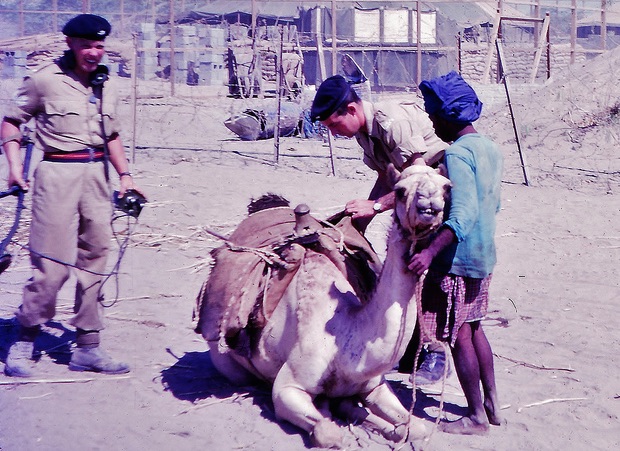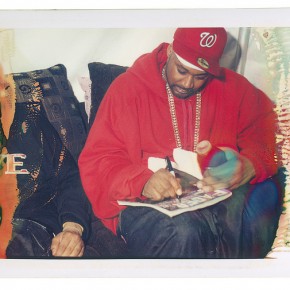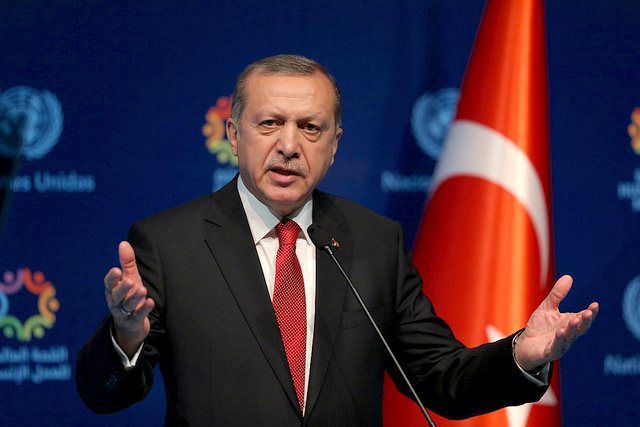After our journeys in South Africa and Abyssinia, it was suggested to my husband that a survey of the Hadhramout by an independent traveller would be useful to the Government; so in the winter of 1893 – 94 we determined to do our best to penetrate into this unknown district.
Anciently, it was the centre of the frankincense and myrrh trade, one of the most famed commercial centres of ‘Araby the Blest,’ before Mohammedan fanaticism blighted all industries and closed the peninsula to the outer world.
In the proper acceptation of the term, the Hadhramout at the present time is not a district running along the south-east coast of Arabia between the sea and the central desert, as is generally supposed, but it is simply a broad valley running for 100 miles or more parallel to the coast, by which the valleys of the high Arabian table-land discharge their not abundant supply of water into the sea at Saihut, towards which place this valley gradually slopes. […]
Owing to the intense fanaticism of the inhabitants, this main valley has been reached only by one European before ourselves; namely, Herr Leo Hirsch, in 1893. In 1846 Von Wrede made a bold attempt to reach it, but only got as far as the collateral valley of Doan. My husband and I were the first to attempt (in the latter part of 1893 and the early part of 1894) this journey without any disguise, and with a considerable train of followers.
I think, for this very reason, that we went openly, we made more impression on the natives, and were able to remain there longer and see more, than might otherwise have been the case, and to establish relations with the inhabitants which, I hope, will hereafter lead to very satisfactory results.

Having arrived at Aden with letters of recommendation to the Resident from the Indian Government and the India Office, besides private introductions, we were amazed at all the difficulties thrown in our way. It quite appeared as if we had left our native land to do some evil deed to its detriment, and we were made to feel how thoroughly degrading it is to take up the vocation of an archaeologist and explorer.
[…] We had no assistance beyond two very inferior letters to the sultans of Makalla and Sheher, which made them think we were ‘people of the rank of merchants,’ they afterwards said. Imam Sharif has travelled much with Englishmen, so he speaks our language perfectly, and having a keen sense of humour, plenty of courage and tact, and no Mohammedan prejudices, we got on splendidly together. He was a very agreeable member of the party. My husband paid all his expenses from Quetta via Bombay, with three servants, including their tents and camp equipage, and back to Quetta.
Our party was rather a large one, for besides ourselves and our faithful Greek servant Matthaios, who has accompanied us in so many of our journeys, we had with us not only the Indians, but a young gardener from Kew, William Lunt by name, as botanist, and an Egyptian named Mahmoud Bayoumi, as naturalist, sent by Dr. Anderson, whose collections are now in the British Museum of Natural History at South Kensington. […]
An interpreter was recommended to us by the native political agent at Aden, Saleh Mohammed Jaffer, Khan Bahadur: a certain Saleh Hassan. He proved to be a fanatical Moslem, whose only object seemed to be to terrify us and to raise enemies against us, in order to prevent our trampling the holy land where Mohammed was born. Throughout our journey, he was a constant source of difficulty and danger. […]
Our starting-point for the interior was Makalla, which is 230 miles from Aden, and is the only spot between Aden and Maskat which has any pretensions to the name of port. The name itself means ‘harbour.’ It is first mentioned by Ibn Modjawir; Hamdani calls it El Asa-Lasa, and Masudi gives the name as Lahsa. The harbour is not available during the south-west monsoon, and then all the boats go off to Ras Borum or the Basalt Head. […]
Beyond the Bab Assab are huts where dwell the Bedouin who come from the mountains. They are not allowed to sleep within the town. There is a praying-place just outside the gate. In the middle of the town is a great cemetery full of tamarisks, and containing the sacred tomb of the sainted Wali Yakoub in the centre.
We were amused by a dance at a street corner to the beating of drums. It consisted of a hot, seething mass of brown bodies writhing about and apparently enjoying themselves. […]
About five generations ago the Seyyids of the Aboubekr family, at that time the chief Arab family at the Hadhramout, who claimed descent from the first of the Khalifs, were at variance with the Bedou tribes, and in their extremity they invited assistance from the chiefs of the Yafei tribe, who inhabit the Yafei district, to the north-east of Aden. To this request the Al Kaiti family responded by sending assistance to the Seyyids of the Hadhramout, putting down the troublesome Bedou tribes, and establishing a fair amount of peace and prosperity in the country, though even to this day the Bedouin of the mountains are ever ready to swoop down and harass the more peaceful inhabitants of the towns.
At the same time the Al Kaiti family established themselves in the Hadhramout, and for the last four generations have been steadily adding to the power thus acquired. Makalla, Sheher, Shibahm, Haura, Hagarein, all belong to them, and they are continually increasing, by purchase, the area of their influence in the collateral valleys, building substantial castles, and establishing one of the most powerful dynasties in this much-divided country. […] The power and wealth of this family are almost the only guarantee for peace and prosperity in an otherwise lawless country. […]
The so-called palace in which we were lodged was next to the mosque and close to the bazaar; the smells and noise were almost unendurable, so we worked hard to get our preparations made, and to make our sojourn here as short as possible. This ‘palace’ was a large building; a very dirty staircase led to a quantity of rooms, large and small, inhabited in rather a confusing manner, not only by our own party, but by another, and to get at our servants we had to pick our way between the prostrate forms of an Arabian gentleman and his attendants. […]
We were six days at Makalla arranging about camels and safe conduct, and wondering when we should get away; so of course we had plenty of time to inspect the town, which on account of the many Parsees had quite an Indian air in some parts. Sometimes one comes upon a deliciously scented part in the bazaars where myrrh and spices, attar of roses, and rose leaves are sold in little grimy holes almost too small to enter; but for the part near the fish market, I can only say that awful stenches prevail, and the part where dates and other fruits are sold is almost impassable from flies.
For our journey inland we were entrusted by the sultan to a tribe of Bedouin and their camels. Mokaik was the name of our Mokadam or head-man, and his tribe rejoiced in the name of Khailiki. They were tiny spare men, quite beardless, with very refined, gentle faces; they might easily have been taken for women, so gentle and pretty were they. […] They are very different from the stately Bedouin of Syria and Egypt, and are, both as to religion and physique, distinctly an aboriginal race of Southern Arabia, as different from the Arab as the Hindoo is from the Anglo-Saxon.
Our ideas as to Bedouin and Bedawi, the latter word which we never heard while we were in Southern Arabia, were that they were tall, bearded men, not very dark in colour, and our imaginations connected them with hospitality and much clothes. None of these characteristics are found among the Bedouin of this district. Bedouin is not a word in use, but Bedou for both singular and plural. […]
Before proceeding further with our journey, I will here say a few words concerning the somewhat complex body politic of this portion of Arabia, the inhabitants of which may be divided into four distinct classes.
Firstly, there are numerous wild tribes of Bedouin scattered all over the country, who do all the carrying trade, rear and own most of the camels, and possess large tracts of country, chiefly on the highlands and smaller valleys. They are very numerous and powerful, and the Arabs of the towns are certainly afraid of them, for they can make travelling in the country very difficult, and even blockade the towns. They never live in tents, as do the Bedouin of Northern Arabia; the richer ones have quite large houses, whilst the poorer ones (those in Shabwa and the Wadi Adim, for instance) dwell in caves.
Secondly, we have the Arabs proper, a decidedly later importation into the country than the Bedouin. They live in and cultivate the lands around the towns; many of them carry on trade and go to India and the Straits Settlements, and some of them are very wealthy. They also are divided into tribes. The chief of those dwelling in the Hadhramout are the Yafei, Kattiri, Minhali, Amri, and Tamimi. The Bedouin reside amongst them, and they are constantly at war with one another, and the complex system of tribal union is exceedingly difficult to grasp.
Thirdly, we have the Seyyids and Sherifs, a sort of aristocratic hierarchy, who trace their descent from the daughter and son of the Prophet. Their influence in the Hadhramout is enormous, and they fan the religious superstition of the people, for to this they owe their existence. They boast that their pedigree is purer than that of any other Seyyid family, even than those of Mecca and Medina. Seyyids and Sherifs are to be found in all the large towns and considerable villages, and even the Arab sultans show them a marked respect and kiss their hands when they enter a room.
They have a distinct jurisdiction of their own, and most disputed points of property, water rights, and so on, are referred to their decision. They look with peculiar distrust on the introduction of external influence into their sacred country, and are the obstructionists of the Hadhramout, but at the same time their influence is decidedly towards law and order in a lawless land. They never carry arms.
Lastly, we have the slave population of the Hadhramout, all of African origin, and the freed slaves who have married and settled in the country. Most of the tillers of the soil, personal servants, and the soldiers of the sultans are of this class.
Adapted from the book Southern Arabia, by J. and Mrs. Theodore Bent (chapter 6, “Makalla,” pages 71 to 81). Photographs courtesy of Brian Harrington Spier. Published under a Creative Commons License.





